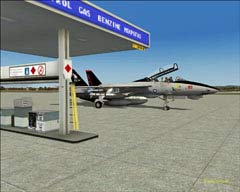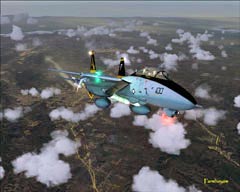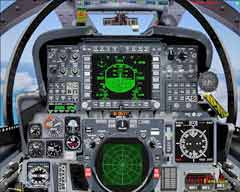Thanks For The Visit !
Farmboyzim's Freeware Finds
The F14 D Tomcat
Review by Farmboyzim
Farmboyzim's Flight Sim's


The Grumman F-14 Tomcat is a United States Navy supersonic, twin-engine, swing-wing , two-seat. The Tomcat's primary missions are air superiority and fleet air defense, though it later acquired the ability to strike ground targets with precision munitions. It entered service in 1972 with the USN, replacing the F-4 Phantom II. It was later exported to the Imperial Iranian Air Force (IIAF) in 1976. It was retired from the USN in 2006, replaced by the F/A-18E/F Super Hornet, though it remains in service with the IIAF. Click here to view image of the last F14 to fly a combat mission.
The F-14 was developed to take the place of the General Dynamics F-111B, the aborted navalized version of the TFX project. The Navy requirement called for a long-range, high-endurance interceptor. Navy doctrine for defending against the new Soviet jet bombers armed with nuclear anti-ship missiles involved defense in depth, with the outer ring consisting of interceptors functioning as high-speed

missile platforms. This requirement was originally to be filled by the cancelled F6D Missileer. The most significant problem with such a design was accommodating the contradictory demands of high speed, long range, and low landing speeds for carrier operations. Variable geometry wings offered a solution to this conundrum.

The Tomcat is said to be named for the late Vice Admiral Thomas Connolly, whose testimony before the Senate was critical in the cancellation of the TFX project. Connolly's call sign was "Tomcat," hence the popular name which also conformed with the Navy's tradition of giving feline names to Grumman fighters. In addition, "Tomcat" was first suggested for the Grumman F7F in 1943, but it was rejected by the Navy as being inappropriately suggestive.
To facilitate the rapid entry of the F-14 into service, the Navy planned to recycle the engine and avionics from the F-111B for the initial version, and progressively introduce new avionics and weapons systems into the airframe. The designation F-14A was assigned to the airframe equipped with updated TF-30 engines and the AN/AWG-9 weapons system from the F-111B. It first took flight December 21, 1970.

The original plan was to only build a few F-14As, as the TF30 was known to be a troublesome engine. In addition, the engine was not designed for rapid thrust changes or a wide flight envelope and only supplied 74% of the intended thrust for the F-14. An F-14B would follow in November 1987 using the engine from the advanced technology engine competition. The F-14C was intended to denote a varient implementing a replacement for the AN/AWG-9. However, it was delayed, and this variant was never produced. When it finally arrived as the AN/APG-71 , the designation assigned to the new aircraft was F-14D, which first flew November 24, 1987. Because of its popularity, and long service life, the Navy is attempting to place as many of its retired F-14's on public display as possible. Consequently, aircraft mothballed at the Davis-Monthan "Boneyard" will be retained for as long as possible while homes are found for them. (This info, and much more, can be found at en.wikipedia.org.)
This is just the jet for all you power freaks out there! I still can't believe this aircraft was retired. To put it simply, this is a fantastic model! The 2D panel is extremely detailed and functional. The VC mode is also very readable and functional and includes an interactive 3D radar gauge. You get a nice sense of realism while in either of the views! The image above is from the RIO view. Gauges galore, with your standard avionics that you'd find in the average model, and then there's the extras, like the special radar gauges for landings, TCAS, and terrain. A host of great liveries are included with various configurations. Very nice texturing on all parts of the model. This is a great model for both flying and screenshots. Functioning swingwings, and nicely rendered pop up panels are all part of the package. Aerodynamically, it feels like a powerhouse, and from what I've been told, the flight modeling is about as close to the real thing as you can get! You can also "feel" the lift of the wings when they are swept forward by using the flaps command. The sounds are great, as well as the exceptional "sonic boom" effects which include both the sound and the transonic vapor effects. This is a popular aircraft on the Multiplayer Server also, for it's great handling characteristics while formation flying. Oh, and you may see it in a few screen shots here and there!
Here's a sampling of the excellent avionics and gauges that are included in this model...
FS2004 Gauge: sRadar80, navigational radar- This nose-mounted, forward-scanning radar will display simulated echoes from ground-based targets that will assist navigation. Screen blips represent FS objects located within the simulator world. With six ranges available (2nm-80nm), cross-country radar navigation and low visibility approaches are possible.
An application KEY CODE is included to pop into the FSUIPC.dll (which is a freeware product BTW) in order to make the F16.gau by Eric Marciano function. With this gauge, you are able to do the cat shots off the decks of carriers and also perform the traps.
A lot of effort, hours, sweat, and probably a few tears went into the making of this model, and, like it's real life counter part, was developed by a host of designers, developers, painters, and FDE'ers (I think I just made that one up!). One can see why this model is one of the most popular for downloading across the web! There is a bit of work on your part, to get all the files in the right places to make the gauges function properly, but there are easy instructions to follow to get this accomplished. I could go on and on about this model, but since it's FREEWARE, you have no excuse not to check it out!!! Do a search for the file carrierop1146.zip over at Avsim and you'll be "trapping" in no time on some great carrier models stationed out in the beautiful French Polynisian area of the Pacific! The person I've been in touch with about this model is Steve Hinson, who has been kind enough to let me know about all the revisions and any other info about the model, and informed me that Ivan Kostic is responsible for reworking the original aircraft.cfg file, in other words, tweaking this and that (pretty tech sounding, huh?)in order to make this bird scream like the real thing! Ivan was the other "brain" behind this rework project, and as you will read in the credits below, this guy certainly has the qualifications! Below are some more credits out of the files, and like I said, quite a few people made this aircraft possible! Check ot all the docs in the fikes for anything and anyone I may have missed, for they are certainly mentioned in the credit files! From the Freeware Ranks, we salute and thank you!
1. Ivan is responsible for:
a. Reworked original FDE to current Flight Dynamics
b. Reworked S. Printz's "HUD_Hornet.XML" to comply with F14 HUD specs. This bird has the only Velocity Vectored HUD.
c. Supplied 1st panel to Steve for Rework.
d. Reworked Aircraft.cfg to enable fantastic Flight Envelope Stability.
e. Wrote Flight Dynamics Manual in DOCS for others to learn about the Bird. EXCELLENT READ
f. Sound package that comes with this F-14D
g. Flight Test Pilot
2. Steve's hand was into the following:
a. BMP for RIO by Randy Shoemake. Use by me OK'd by Randy S. for my help with their Ultimate Tomcat V3.0
b. Created gauge layout mods for RIO panel. This is the CORRECT D model RIO panel.
c. There are now over 175 functioning gauges! ALL NEEDED FOR CORRECT FLIGHT OPS!
d. Added Rob Barendregt, Doug Dawson, & Nick Needham's Sonic Boom, Transonic Vapor cloud FX at M1.
e. Added Rob, Doug's, & Nicks Catapult, Trap gauging with sound fx to capture realistic carrier deck operations
f. Fixed Aircraft.cfg: ADDED realistic, if not over-juiced, lol, electrical power supply panel. Adjusted Lights to spec.
g. Reworked RGB colors to effect a luminous, brighter RED VC Night Light. using code.
h. Wrote F14D & scenery pack install instructions as needed.
i. Customer Service the Best! ALL inquiries answered in <1 day.
j. Created the "TALKIE": an MP3 instead of READme for complex issues.Used around world. CSB7.1 Audigy S/B s/w
k. Flight Test Pilot, and other things that needed to be done; systems Engineer,
Flight dynamics, FDE rework by Ivan Kostic. Aircraft perfectly controllable & maneuverable within the whole original Tomcat's flight envelope. Sound file by Ivan Kostic. Rework of Scott Printz's HUD_Hornet.XML for HUD development for the F14D and aircraft.cfg original by Ivan Kostic. Aircraft.cfg & Panel.cfg REV 3 rework by Steve Hinson, RCBCO-20 by Rob Barendregt, Doug Dawson & Nick Needham. F14_Effect_Controller.XML by Rob Barendregt. F16 Radar by Eric Marciano. Original main panel base.bmp by Frank Elfert. RIO panel by Randy Shoemake, one copy authorized by the author, Randy, for my help given to Randy towards the rework of the Ultimate Tomcat F14B by ProsoftSimulation 7/3/6. Email on file. Rework of the main/RIO panels, gauge layout & rework for accuracy, VC upgrade & texture code added with the aircraft.cfg adjusted by Steve. Artists: Pascal Flemming: VF-31 "Topcatters"; VF-154 "Black Knights"; VF-101CAG, "Cag-Long Range Interceptor"; & VF-14 "Tophatters"; VF-84 "Jolly Rogers", VF-142 "Ghostriders" by Jared Stucki; VF-103 "Jolly Rogers" by Dino Cattaneo; VX-4 "Evaluators" by Aaron Haase; Custom memorial "Baby Girl Pink" texture for my late granddaughter: "Elijah Marie Hinson": 01/03/01-02/17/01 by Ardie Tingleman. Glenn Copeland & Eugene Heyart gauges, FSD for standard mil-gauges. Daisuke Yamamoto & Super Hornet "KBT" Team's Primary ADI Display Gauge. MSFT default gauges used where feasable and logical: close as possible to see. Gmax model by Jeff Dobbings & Dino Cattaneo. Rev 3 rework & our original files by Ivan & Steve."
Here's the liveries that come with this model...






















Email me if you want to form a "Virtual Squadron" for some regular flights! How's "Farmboyzim's Flying Circus" (sort of in honor of the original "Flying Circus" from WW I) sound? Always open for suggestions though! Click Here if you're interested!
























